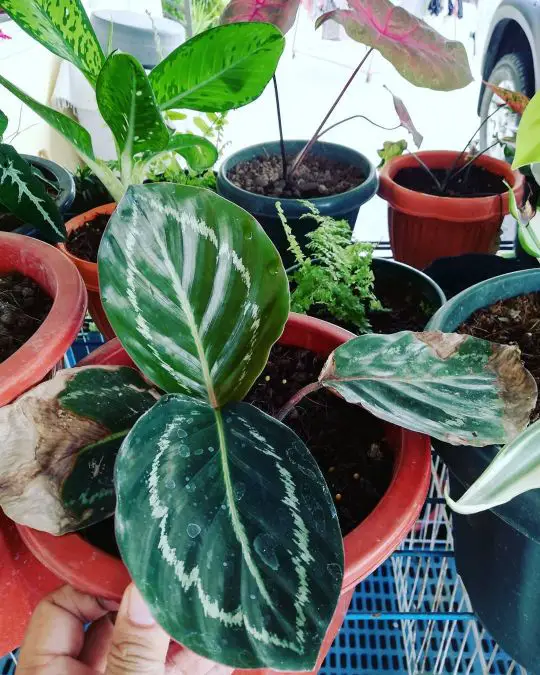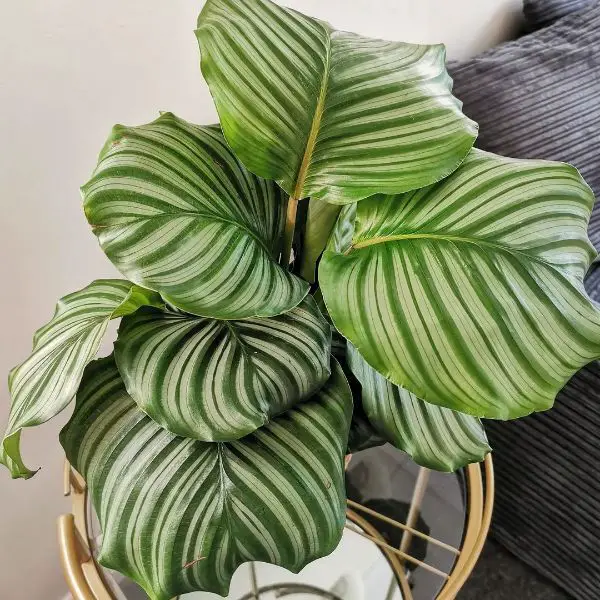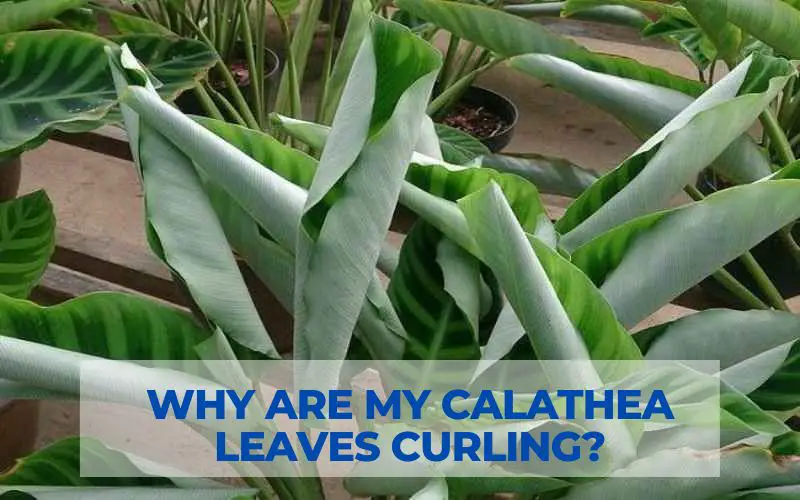Have you been noticing lately why are my Calathea leaves curling? This can be a sign of several problems, ranging from overwatering to root rot. In this blog post, we’ll show you how to identify and fix the problem causing your Calathea’s leaves to curl. Keep reading for more information.
Why are my Calathea leaves curling?
If you notice your Calathea leaves curling, it’s important to take a closer look at the plant to determine the cause. There are several reasons why Calathea leaves may curl, including Too much sunlight, Too little water, Temperature changes, Overwatering, Watering with Hard Water, Overfeeding with Fertilizer, Low Humidity, and Pest Infestation,…

Causes of Calathea Leaf Curling
If you can identify the cause of your Calathea’s leaves curling, you can take steps to fix the problem.
Too much sunlight
If your Calathea is getting too much direct sunlight, the leaves may start to curl as a way to protect themselves from the intense light.
Furthermore, intense sunlight exposure creates concentrated heat on the leaves, which enhances the rate of transpiration.
Signs of Calathea leaves curling caused by direct sunlight
- Sunburn is the most likely reason for your Calathea leaves curling inward and browning at the tips.
- Check your temperature and make sure it’s between 65°F and 80°F (18°C and 27°C) for ideal Calathea growing conditions.
Solutions:
- Move your plant to a spot that gets less sunlight
- In order for your Calathea to grow, you should select a room with a shaded east-south facing window that receives indirect filtered sunlight
Too little water
If the soil is too dry, the leaves will start to curl as a way to conserve water.
Signs of Calathea leaves curling caused by underwatering
- On your Calathea, look for drooping leaves that are yellowing and browning.
- Place a soil metre probe halfway down in your pot and check the reading to see how wet the soil is. If it’s less than 3, the plant isn’t getting enough water.
Solutions:
- Calathea plants should be watered once a week or when the top two inches of soil are dry. Make sure you’re watering your Calathea regularly and that the soil is moist but not soggy
- Fill it with distilled or filtered water until you see water draining from the bottom holes.
Temperature changes
Sudden changes in temperature can also cause Calathea leaves to curl. If you recently moved your plant or it’s been exposed to drafts, the leaves may start to curl as a way to adjust to the new environment.
Solutions:
Try to keep your Calathea in a consistent, warm spot and out of any drafts.
Overwatering
Overwatering your Calathea will cause root rot by clogging its roots. Because the roots have been injured, they are unable to absorb nutrients or water, resulting in dehydration.
Signs of Calathea curling leaves by overwatering
On Calathea, browning at the tips of the leaves is the first sign of overwatering.
A strong, unpleasant stench will pervade the soil, which is typically an indication of root rot.
If your soil is still moist after a week or two, it’s typically a sign of poor drainage and overwatering.
Solutions:
- First, make sure you’re only watering your plant when the soil is dry. If the soil is constantly moist or soggy, it can lead to root rot, which can cause the leaves to curl.
- Second, make sure you’re using a well-draining potting mix. If the potting mix doesn’t drain well, the roots can sit in water and become soggy, which can also cause the leaves to curl.
- Finally, make sure you’re not watering your plant with cold water. Cold water can shock the roots and cause the leaves to curl. If you think your plant is overwatered, take steps to fix the problem and your Calathea should soon be back to normal!
Watering with Hard Water
If your water is hard, it can contain minerals that can build up in the soil and cause the leaves to curl.
It might be dangerous to your Calathea if you water them with tap water that contains salts, fluoride, and calcium carbonate.
According to research by Penn State: “Fluorine can adversely affect plants at concentrations as low as .1 part per million. In some municipal water supplies, 10 times that amount is added to prevent tooth decay.”
Fluoride buildup on Calathea leaf tissue inhibits photosynthesis and damages the tissue. Water will flow from the plant’s root back into the soil when salts and calcium carbonate build up near the roots.
Signs of rattlesnake Calathea leaves curling caused by watering with hard water
- Leaves turn dry and brittle with yellowing or browning
- As hard water evaporates, it leaves behind a white chalky residue on leaves, stems, and even soil.
Solutions:
- You can either use distilled water or water your plant with rainwater. If you don’t have access to distilled water or rainwater, you can let your tap water sit for 24 hours before watering your plant. This will allow the minerals to settle out of the water and make it safe for your plant.
- It’s preferable to repot your Calathea to new fresh soil if the soil has accumulated too much salt.
Overfeeding with Fertilizer
If you’ve been overfeeding your Calathea with fertilizer, the leaves may start to curl as a way to protect themselves from the chemicals. Overfertilization can cause the soil surrounding the roots to become oversaturated with salts, causing water moisture to be pulled out of the plants rather than absorbed.
The plant will become dehydrated and coil up as a result of the lack of water. Salt accumulation in the soil may be rectified, but if left uncontrolled, it can eventually cause root burn damage and kill your Calathea.
Signs of Calathea curling leaves caused by overfeeding with fertilizer
- You’ll notice a crusty build-up on the borders of your pots or on the top of the soil if you use too much fertilizer.
- If the lower leaves are yellowing and withering, and the leaf edges and tips are browning, your Calathea has been over-fertilized.
- If you see any of the aforementioned symptoms, look for black-brown or decaying roots, which are frequently caused by overfertilization.
Solutions:
- If you think this may be the case, stop fertilizing your plant and see if the leaves start to uncurl.
- You may also need to flush the soil with water to remove any excess fertilizer.
- If you continue to overfeed your Calathea, it can lead to root burn, which can kill your plant. So be sure to only fertilize your plant when necessary!
Low Humidity
Calathea’s transpiration rate can rise dramatically when the relative humidity falls below 50%, resulting in excessive water loss and leaf curling.
Signs of rattlesnake Calathea leaves curling caused by low Humidity
- Low humidity and underwatering both result in drooping, browning, crunchy leaves, making it difficult to distinguish between the two.
- Investing in a hygrometer will allow you to correctly measure your humidity level.
Solutions:
You can try misting your plant or placing it on a pebble tray. Misting will help to increase the humidity around your plant, and the pebbles will help to hold the moisture in. You can also try using a humidifier to increase the humidity in the room. If you live in a dry climate, you may need to do all of these things to keep your Calathea happy!
Pest Infestation
Aphids, Mealybugs, and Spider Mites are the most prevalent pests that feed on the tissues and sap of Calathea plants. These bugs can disfigure the leaves and cause them to curl.
Calathea leaves curling signs due to Pest Infestation
Spider mites are difficult to detect, although wrinkled and dried leaves with webbing down the underside might be a sign. You’ll see little webbing where the leaf and stem connect as the infestation grows and their numbers increase.
Solutions:
- You can use a pesticide or an insecticidal soap to kill the pests
- You can also try using a cotton swab dipped in rubbing alcohol to remove mealybugs
- If you have a serious infestation, you may need to take your plant outside and spray it with water to remove all of the pests
- Wiping your Calathea leaves on a regular basis will aid in early detection of any insect infestation.

Read More: How Big Does Calathea Grow? Here’s The Real Answer
Tips for preventing your Calathea leaves from curling in the future
As a plant lover, you may be familiar with the frustration that comes with seeing your Calathea leaves curl. These can prevent your Calathea leaves from curling.
- Water your plant only when the soil is dry
- Use a well-draining potting mix
- Don’t water your plant with cold water
- If you have hard water, use distilled water or rainwater to water your plant
- Keep an eye out for pests and diseases and take steps to treat them immediately
- Don’t overfeed your plant with fertilizer
- Increase the humidity if the air is too dry
If you have a Calathea, it’s important to understand why are my Calathea leaves curling? Calatheas like plenty of humidity and indirect light. Curled leaves could mean that your plant is too dry, or doesn’t have enough light.


